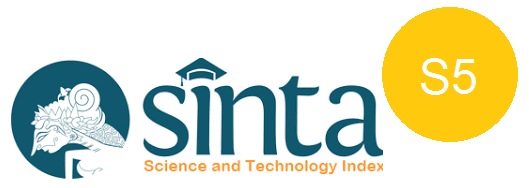Functional Systemic Linguistic Approach in Translation Studies of Taxis Markers in "WoY"
DOI:
https://doi.org/10.47313/pujangga.v9i2.2856Keywords:
Translation, Interdependency, Semantic Logic, Paratactic, Taxis, NovelAbstract
Waiting on You (WoY) is the work of Kristan Higgins, a New York Times bestselling author whose novel was also translated into Indonesian by Nina Andiana. Higgins consistently uses complex clauses in writing novels. As a result, long complex clauses are difficult to translate. This research refers to the Functional Systemic Linguistics approach which aims to: explain the interdependence and semantic logic of complex clauses in source language text are translated into interdependence and semantic logic of complex clauses in recipient language text in novel WoY; Taxis marker translation technique used in translating from source language text to recipient language; the shifts found in the translated novel Penantian Terpanjang; the quality of translation of complex clauses in target language. This method is descriptive qualitative with taxis as an object in the novel WoY, sourced from source language texts and recipient language texts from the novel entitled Penantian Terpanjang, and obtained from informants who are linguistic and translation experts. The technique is purposive sampling. Techniques of collecting data are document analysis and focus group discussions. The data validity is triangulation. The results are after breaking down sentences into clauses and analyzing them, researchers find that the most dominant form (interdependence) is paratactic, and the meaning (semantic logic) that is most widely used is the extension. Meanwhile, the most widely used technique is common. The types of shifts found are form (interdependence) and meaning (semantic logic). This shift has a positive effect on readability so that it can improve the quality of the novel translation.References
Ansar, F. A. (2017). Taxis Markers in the teaching-learning process. English Education: Jurnal Tadris Bahasa Inggris, 10(1), 29-45. Diakses pada tanggal 17 Oktober 2022.
Barman, U., Das, A., Wagner, J., & Foster, J. (2014, October).Taxis: A challenge for language identification in the language of social media. In Proceedings of the first workshop on computational approaches to code-switching (pp. 13-23). Diakses pada tanggal 10 September 2022.
Baker, P. (2010). Functional Systemic Linguistics and corpus linguistics. Edinburgh University Press Diakses pada tanggal 11 November 2022.
Daulton, F. E. (2018). Japanese learners' built-in Taxis of English. LANGUAGE TEACHER-KYOTO-JALT-, 31(9), 15. Diakses pada tanggal 3 Januari 2023.
Gambier, Y. (2015). Translation strategies and tactics. Handbook of translation studies, 1, 412-418. Diakses pada tanggal 19 Desember 2022.
García, O. i Wei, Li. (2014). Language, bilingualism, and education. Diakses pada tanggal 4 Desember 2022.
HILMAN, E. H. (2015). The translation of Indonesian cultural lexicons in the novel Saman. Lingua Cultura, 9(1), 67-74. diakses pada tanggal 7 Oktober 2022.
Hollmann, W. B. (2017). Cognitive sociolinguistics. The Cambridge Handbook of Cognitive Linguistics, 533-548. Diakses pada tanggal 13 September 2022.
Kustati, M. (2014). An analysis of Taxis Markers in EFL teaching of cross-cultural communication context. Al-Ta lim Journal, 21(3), 174-182. Diakses pada tanggal 8 Oktober 2022.
List, J. M. (2019). Automated methods for the investigation of language contact, with a focus on lexical borrowing. Language and Linguistics Compass, 13(10), e12355. Diakses pada tanggal 2 November 2022.
Llamas, C., & Watt, D. (2014). Scottish, English, British?: innovations in attitude measurement. Language and Linguistics Compass, 8(11), 610-617. Diakses pada tanggal 10 Oktober 2022.
McKay, S. L. (2016). Functional Systemic Linguistics and Language Education (Vol. 18). Bristol: Multilingual Matters. Diakses pada tanggal 20 November 2022.
Meyerhoff, M. (2018). Introducing Functional Systemic Linguistics. Routledge. Diakses pada tanggal 11 September 2022.
Musyarrofah, M. (2019). Taxis Markers used by Radio Broadcasters in GEN FM, EBS FM, and Prambors FM Radio Channel in Surabaya (Doctoral dissertation, UIN Sunan Ampel Surabaya). Diakses pada tanggal 9 Desember 2022.
Narawaty, D. (2023). Pergeseran dan Pemertahanan Bahasa di Timor-Leste: Suatu Kajian Sosiolinguistik. Pujangga: Jurnal Bahasa dan Sastra, 9(1), 108-122.
Othman, W., & Qutob, D. A. (2022). Taxis and logico-semantic relations in English-Arabic translation. InTRAlinea: Online Translation Journal, 24.
Sebba, M. (2014). Multilingual web discussion forums: theoretical, practical and methodological issues. Language mixing and Clause of Sentences in writing: Approaches to mixed-language written discourse, 106-27. Diakses pada tanggal 5 November 2022.
Siregar, M., Bahri, S., & Sanjaya, D. (2014). Penanda Taksis in Indonesia: Study in Linguistik Sistemik Fungsional. English language and literature studies, 4(1), 77-92. Diakses pada tanggal 25 Oktober 2022.
Sundoro, B. T., Suwandi, S., & Setiawan, B. (2018). Penanda Taksis dalam Pembelajaran Cerpen Bahasa Indonesia di Sekolah Menengah Kejuruan. " RETORIKA" jurnal bahasa, Sastra dan pengajarannya, 11(2), 129-139. Diakses pada tanggal 17 September 2022.
Walenta, M. (2019). Research method. Form-Function Mapping in Content-Based Language Teaching: A Study of Interlanguage Restructuring, 115-154. Diakses pada tanggal 6 Desember 2022.
Wei, L. (2020). Dimensions of Functional Systemic Linguistics. In The bilingualism reader (pp. 3-22). Routledge. Diakses pada tanggal 7 November 2022.
Zhou Li-na. (2016). Taxis Markers are in modern English and their features. Sino-US English Teaching Journal, 13(3), 209-212. Diakses pada tanggal 30 Oktober 2022.








